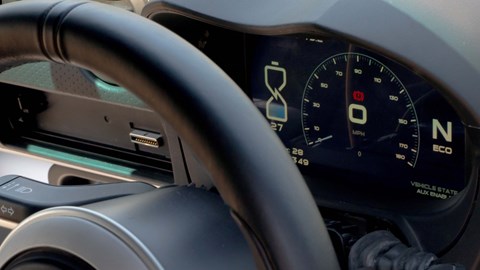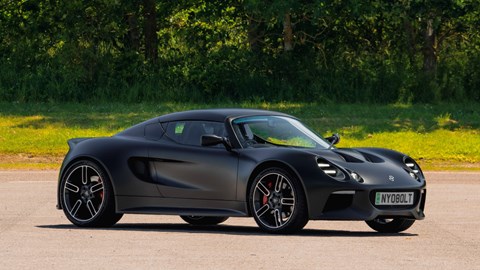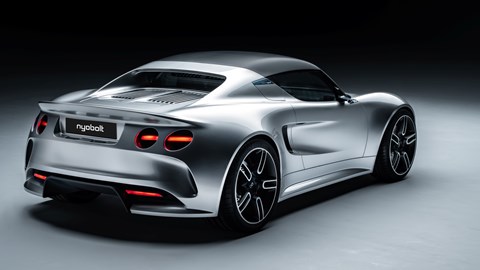► Nyobolt EV now fully functioning prototype
► 1250kg Electric Lotus Elise with 155-mile driving range
► Proven 10-80 per cent charge in under five minutes
British battery-tech firm Nyobolt is now able to demonstrate 10-80 per cent charging that takes less than five minutes in its fully functional Nyobolt EV prototype. The Cambridge-based firm says its patented next-generation ‘carbon and metal oxide anode’ materials and low impedance battery cell design can therefore deliver twice the charging speed of most of the best electric cars currently on sale.
What’s more, Nyobolt says its new batteries will maintain performance for up to 600,000 miles – and can prove this thanks to successful completion of over 4000 full DoD (Depth of Discharge) fast charging cycles. That too is a considerably greater battery lifecycle than present technology claims.
The low impedance cell design also helps to keep temperature under control, meaning that even in fast charging or during high-speed driving, the battery pack never exceeds 60 degrees. With integrated control systems and cooling solutions, Nyobolt suggests its new tech could easily be retrofitted into existing EV platforms.
Wait. Doesn’t the charging time also relate to the size of the battery?
We had the same thought – and it’s true that the Lotus Elise-based Nyobolt EV demonstrator has a tiny (by modern standard) 35kWh battery pack. But this and the associated 155-mile WLTP driving range perhaps matters less if you can consistently charge it that quickly, as this tech claims. And keeping the battery small does mean controlling the kilos, as well as the cost. The demonstrator is said to weight just 1250kg. A lot for a Series 1 Elise (which came in at under 800kg), but not much for an EV.

Nyobolt’s point, however, is that its battery tech can maintain its maximum charging capability for longer. Using a 350kW 800v DC fast charger, that 10-80 per cent run has been clocked at just four minutes 37 seconds – with the first four minutes maintaining a constant 500A current, and equating to 120 miles of extra driving range on their own.
For context, the latest Porsche Taycan battery and charging tech can achieve 10-80 per cent in 18 minutes in optimum conditions – which Porsche has put quite a bit of effort into helping owners understand, including adding a predictive charging time display into the instrument cluster options. This is on a 97kWh battery pack, using 320kW 800v DC. As a result, Porsche says it can add 186 miles of range in 10 minutes to a car weighing over 2200kg.
The Taycan’s previous battery technology has a less than flawless reliability record, though.

Nyobolt is already ‘in conversation’ with multiple OEM vehicle manufacturers about the adoption of its novel solution, with robotics and heavy goods applications also being explored.
What is the Nyobolt EV?
A decade and a half after some upstart firm out of California used the Lotus Elise as a starting point for an electric car, Norfolk’s finest is getting another lease of life. The Nyobolt EV is the product of battery firm Nyobolt and design agency CALLUM, and utilises the talents of the Elise’s original designer, Julian Thomson.
The Nyobolt EV was conceptualised by Thompson before he joined GM and finished off by CALLUM, the eponymous design house founded by ex-Jaguar designer Ian Callum. Design talent meets groundbreaking tech, too – Nyobolt claims to have solved several of the existing problems with lithium-ion batteries.
Looks like a S1 Elise to me
You know when sci-fi movies use existing cars but put them on dished wheels and fit funkier lights to them? That’s the sort of universe the Nyobolt’s come from. Thomson’s reimagined the Lotus Elise but with ‘exaggerated proportions’ – this EV is 100mm wider and 150mm longer than its inspiration. It sits on 19-inch wheels and the body panels (none of which are shared with the Elise) are a lightweight composite.

A raised waistline makes the silhouette even more dramatic, while LED lights front and rear help modernise it. On the concept (the silver car in the pictures), the Rover Metro door mirrors of the original were swapped out for cameras. But the functional prototype has returned to the use of old-school reflective surfaces – a decision we commend.
The charging port’s discreetly located just behind the door on the B-pillar, and most importantly the roof panel lifts out for open-topped motoring. ‘The aim was to evolve the design and bring it up to date while keeping that iconic sports car character that was so well received in the Elise,’ explained Aleck Jones, creative lead at CALLUM.
‘Typically, you run into feasibility issues with initial sketches and a design loses impact as it moves from concept into reality, but incredibly – and thanks to the close working relationship between CALLUM’s design and engineering teams – we have been able to realise our early images and unique vision in the real world.’
Tesla famously used an Elise as the basis for its Roadster back in the noughties – something that CEO Elon Musk admitted was a ‘super dumb strategy’, as accommodating a motor and batteries required the platform to be almost totally redesigned.
What’s so groundbreaking about Nyobolt’s battery tech?
Nyobolt achieves a claimed range of 155 miles from 35kWh of battery capacity – that’d mean efficiency of 4.4mi/kWh or thereabouts, which is definitely impressive but more a byproduct of the car’s light weight and slippery shape, we suspect. The Tesla Roadster claimed 244 miles from its 53kWh unit back in 2008.
But Nyobolt claims the batteries themselves are smaller and lighter than those used today, and by simplifying the charging process says that their 35kWh unit can be charged in just six minutes using existing charging infrastructure.
We suspect ‘can’ rather than ‘will’ to be the case here. The maths checks out with the most powerful 350kW chargers currently in deployment at a few dozen sites across the UK, but even under ideal conditions these chargers rarely deploy their full power.

Even if that turns out to be more like ten minutes per charge in the real world, though, it’s highly impressive. Nyobolt says it’s subjected the battery to over 4,000 fast charging cycles ‘without significant performance loss’, and that it can be safely fast-charged to over 80 per cent without damage, something that’s typically not recommended for existing lithium-ion batteries as the heat involved causes the battery to degrade.
Unlocking faster, more stable charging and getting the maximum range out of reasonably-sized batteries is key to improving EVs from the driver’s perspective. The latest long-range flagship models typically stuff in more than 100kWh of cells, which makes the cars immensely heavy, has implications on packaging, and takes eons to charge, especially from home chargepoints.
Unlocking petrol-style recharge times (the average stop at a UK petrol station is claimed to be seven minutes) would solve this problem, even if overall range is reduced. And smaller, lighter batteries would make the cars better to drive, improve packaging, and consume fewer materials (such as dubiously-ethical rare earth metals) in their manufacture.
Plus, small and light batteries mean you can develop small and light cars – like the Nyobolt EV.
Is this a realistic proposition?
The Nyobolt EV may just be a show car at present but the firm isn’t just some upstart making bold claims. Nyobolt received £50m of funding in 2022 to build a battery manufacturing plant in the UK and says low volume production could start in 2024 – ‘ramping up to 1000 packs in 2025.’

Sai Shivareddy, CEO at Nyobolt, said: ‘Unlocking the challenges faced by electric vehicle designers has been key to the development of our breakthrough fast-charging batteries. Previously, enabling a light weight fast-charging vehicle was not possible without compromising its lifetime and so people have been relying on costly and large battery packs in the vehicle. With our unique technology we have achieved a six-minute charge car, and developed smaller battery packs that can deliver more power and charge in less time.
‘Our partnership with CALLUM shows how adoption of system-level technology innovations can transform the future of electric vehicles and increase accessibility of EVs, including to the 40 per cent of UK households who can’t charge their vehicle at home overnight.’